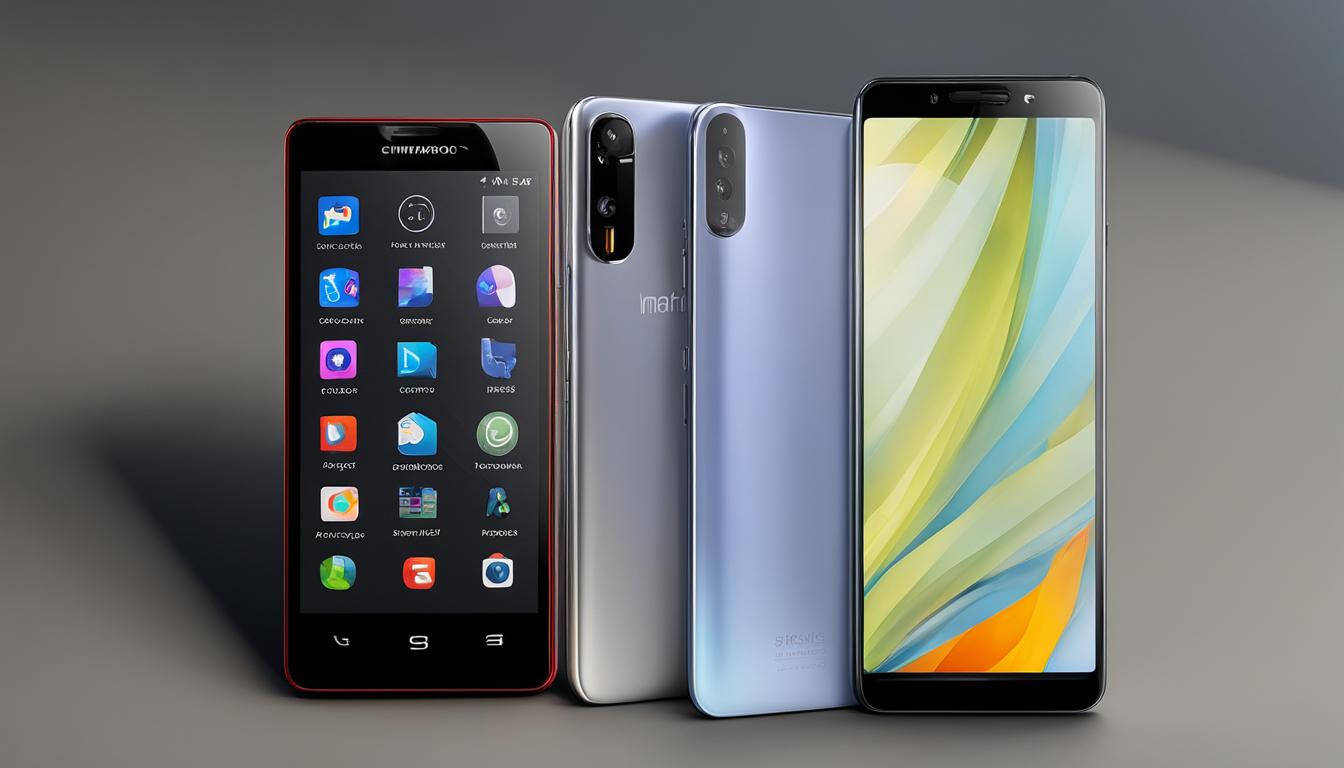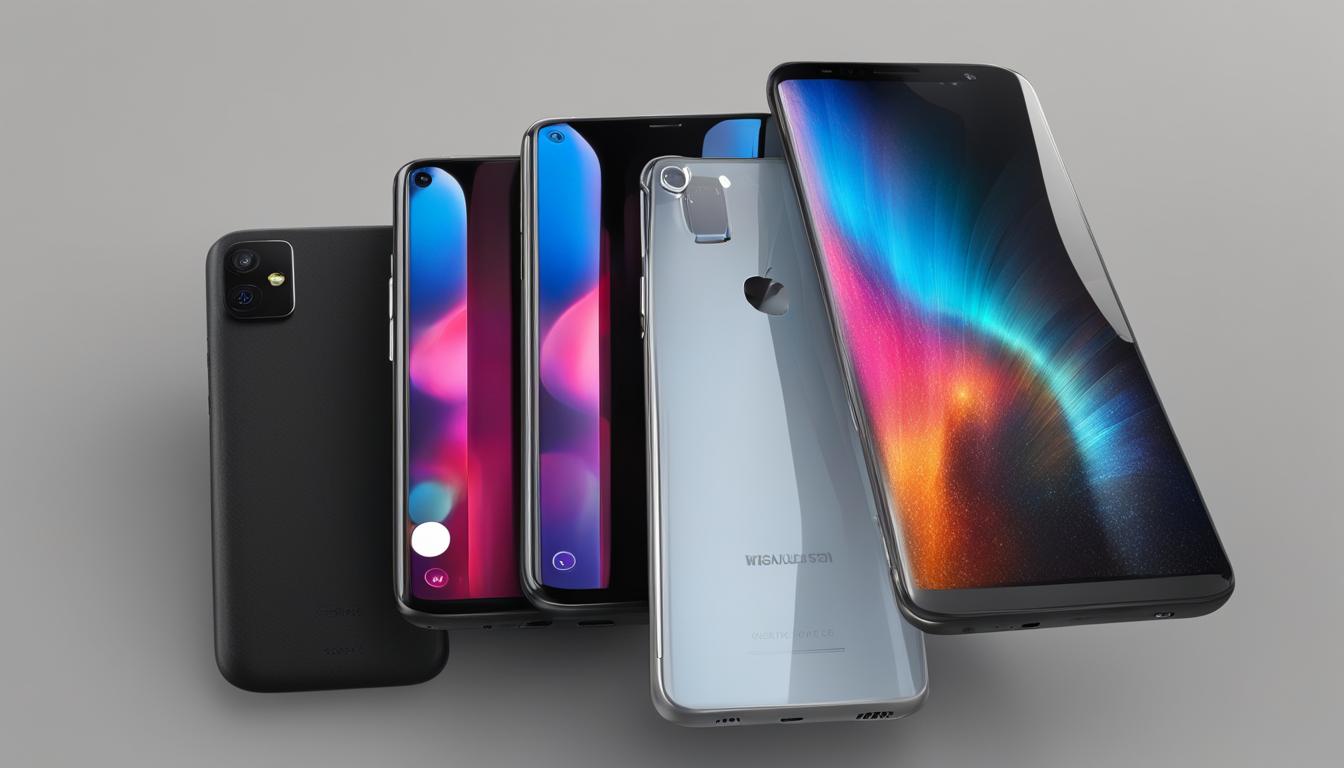Are you curious about the differences between 4G and 5G in mobile connectivity technologies? As our world becomes increasingly connected, it’s important to understand how these two generations of mobile network technology compare. Let’s dive into the details and explore the key distinctions between 4G and 5G.
Key Takeaways:
- 4G and 5G are different generations of mobile network technology, with 5G being the latest
- 4G brought advancements in IoT growth, smartphones, and remote workforces, while 5G aims to address the limitations and improve upon its goals
- 4G, also known as LTE, offers enhanced cell density, improved VoIP capabilities, and greater bandwidth
- 5G utilizes new features and technologies such as network slicing, OFDM, and massive MIMO to provide faster speeds and real-time communication capabilities
- Latency, download speeds, base stations, OFDM encoding, and cell density are key differences between 4G and 5G network architecture
Understanding 4G and LTE
When it comes to mobile network technology, 4G and LTE play a crucial role. 4G, which stands for fourth generation, is the predecessor of the latest generation, 5G. It brought numerous advancements, including enhanced cell density, improved Voice over IP (VoIP) capabilities, and greater bandwidth. LTE, on the other hand, stands for Long Term Evolution and is a standard that was developed during the 4G era. It became the global standard for wireless broadband, ensuring high-performance connectivity.
Both 4G and LTE are essential for providing seamless mobile connectivity. They both support various types of traffic and aim to overcome the limitations of previous generations. With 4G, users experienced faster speeds and improved network performance compared to its predecessors. The introduction of LTE further enhanced these capabilities, enabling faster data transmission and better overall network efficiency.
Table: Comparison between 4G and LTE
| Aspect | 4G | LTE |
|---|---|---|
| Cell Density | Higher | Higher |
| VoIP Capabilities | Improved | Improved |
| Bandwidth | Greater | Greater |
| Global Standard | No | Yes |
As the table above illustrates, both 4G and LTE offer similar benefits in terms of cell density, VoIP capabilities, and bandwidth. However, LTE has the advantage of being a global standard, ensuring compatibility and interoperability across different networks worldwide.
Overall, understanding 4G and LTE is crucial for comprehending the evolution of mobile connectivity technology. While 4G brought significant advancements in network performance, LTE became the global standard for wireless broadband, enhancing connectivity on a global scale.
Introducing 5G
5G is the latest generation of cellular network technology that promises to revolutionize mobile connectivity. With faster network speeds and real-time communication capabilities, 5G aims to exceed the capabilities of its predecessor, 4G. It utilizes new features and technologies such as network slicing, orthogonal frequency-division multiplexing (OFDM), and massive multiple-input, multiple-output (MIMO) to deliver improved performance and user experience.
One of the key advancements in 5G is its use of millimeter wave (mmWave) spectrum, which operates on higher frequencies compared to previous generations. This higher frequency spectrum allows 5G to achieve greater bandwidth, enabling faster download and upload speeds. However, it also requires the deployment of small cell base stations to ensure coverage in densely populated areas.
Another important aspect of 5G is the introduction of 5G New Radio (5G NR), a new standard that aims to replace LTE. 5G NR brings several benefits, including increased energy savings and enhanced connectivity. It supports a wide range of applications and devices, enabling seamless integration of the Internet of Things (IoT) and facilitating the development of smart cities, autonomous vehicles, and other innovative technologies.
Table: Key Features of 5G
| Feature | Description |
|---|---|
| Faster Network Speeds | 5G offers significantly higher network speeds compared to 4G, with the potential to reach up to 10 Gbps. |
| Lower Latency | 5G aims to achieve ultra-low latency, with speeds under 5 milliseconds, enabling real-time communication and supporting applications like remote surgery. |
| Increased Capacity | With its use of new frequency bands and small cell technology, 5G provides greater capacity for more connected devices, supporting the growing demand for IoT and smart devices. |
| Improved Energy Efficiency | 5G NR brings advancements in energy efficiency, allowing devices to operate more efficiently and contribute to a greener environment. |
Overall, 5G represents a significant leap forward in mobile connectivity technology. Its faster speeds, lower latency, increased capacity, and improved energy efficiency make it a promising solution for addressing the growing demands of our digital world. While there are challenges in its implementation and widespread adoption, 5G has the potential to unlock new possibilities and transform industries, bringing us closer to a more connected and technologically advanced future.
Key Differences between 4G and 5G Network Architecture
When comparing the network architecture of 4G and 5G, several key differences emerge. These differences include latency, potential download speeds, base stations, OFDM encoding, and cell density. Understanding these distinctions helps shed light on the advancements and improvements offered by 5G.
Latency
One significant difference between 4G and 5G is latency. Latency refers to the time it takes for data to travel from the source to its destination. 5G offers lower latency, with speeds under 5 milliseconds, compared to 4G’s latency ranging from 60 ms to 98 ms. This reduced latency in 5G enables real-time communication and supports applications like autonomous vehicles and remote surgery.
Potential Download Speeds
Another notable distinction is the potential download speeds of 4G and 5G. 5G aims to increase download speeds up to 10 Gbps, while 4G reached speeds of up to 1 Gbps. This enhancement in download speeds opens up new possibilities for industries and consumers, facilitating faster file transfers, seamless streaming of high-resolution videos, and smoother overall online experiences.
Base Stations and Cell Density
4G primarily relies on traditional cell towers for network coverage. In contrast, 5G utilizes small cell technology and operates on new frequency bands, which require the deployment of small cell base stations alongside existing cell towers. This increased cell density enables 5G to support more users and connected devices in a given area, improving overall network capacity.
OFDM Encoding
Both 4G and 5G utilize Orthogonal Frequency Division Multiplexing (OFDM) encoding, which divides the available frequency spectrum into smaller, overlapping subcarriers. However, there is a difference in the channel sizes. 4G typically uses 20 MHz channel sizes, while 5G employs larger channel sizes ranging from 100 MHz to 800 MHz. This broader channel width in 5G allows for higher data transfer rates and improved network capacity.
Overall, the network architecture of 5G brings several advancements compared to 4G. With lower latency, faster download speeds, increased cell density, and advanced encoding techniques, 5G provides the foundation for transformative technologies and applications that can revolutionize various industries and improve connectivity for users around the world.

A Closer Look at 5G Expectations vs. Reality
As the fifth generation of mobile network technology, 5G has sparked high expectations in terms of performance and capabilities. However, it is important to examine the reality behind these expectations. While 5G promises faster download speeds and lower latency, there are several factors that can affect its real-world performance.
Factors Influencing 5G Performance
One of the main factors that can impact 5G performance is network coverage. While 5G offers impressive speeds and low latency in ideal conditions, the reality is that the coverage is still limited in many areas. The deployment of small cell base stations and the availability of the necessary frequency bands play a crucial role in achieving the full potential of 5G.
Another aspect to consider is the device compatibility. While newer smartphones and devices are being released with 5G capabilities, not all existing devices are equipped to take advantage of the technology. Users may need to upgrade their devices to fully experience the benefits of 5G.
Additionally, the implementation of 5G infrastructure takes time and investment. It requires the installation of new equipment and the upgrading of existing infrastructure. The rollout of 5G networks is a gradual process, and it may take years before it is available nationwide or globally.
The Future of 5G
Despite the current limitations, the future of 5G looks promising. As network coverage expands and more devices become compatible, users can expect to see significant improvements in download speeds, latency, and overall connectivity. The full potential of 5G can be realized as it becomes more widely accessible.
In conclusion, while 5G has generated high expectations, it is important to consider the reality of its current capabilities. Factors such as network coverage, device compatibility, and infrastructure deployment can influence the actual performance of 5G. However, as the technology continues to evolve and expand, users can look forward to experiencing the full benefits of 5G in the near future.
| Factors | Expectations | Reality |
|---|---|---|
| Network Coverage | High-speed, low-latency connectivity everywhere | Currently limited coverage, especially in rural areas |
| Device Compatibility | Compatibility with all devices | Existing devices may not support 5G |
| Infrastructure | Rapid deployment of 5G infrastructure | Deployment is a gradual process, can take years |
The Benefits of 5G Compared to 4G
As the next generation of mobile network technology, 5G offers several key benefits compared to its predecessor, 4G. These benefits include higher speeds, lower latency, increased capacity for connected devices, less interference, and better energy efficiency. Let’s explore each of these advantages in more detail:
- Higher speeds: 5G is designed to provide significantly faster network speeds compared to 4G. With speeds potentially reaching up to 10 Gbps, tasks such as downloading large files or streaming high-resolution videos will become faster and smoother, enhancing the overall user experience.
- Lower latency: 5G boasts significantly lower latency, which refers to the time it takes for data to travel between devices. With latency under 5 milliseconds, real-time communication applications like video conferencing or remote surgery can be supported without noticeable delays, enabling seamless interactions.
- Increased capacity: 5G offers a substantial increase in capacity compared to 4G, allowing for a larger number of connected devices in the same area. This is particularly crucial in today’s world, where the number of Internet of Things (IoT) devices continues to grow rapidly. With 5G, industries like manufacturing and transportation can leverage the increased capacity to connect and manage a multitude of devices simultaneously, leading to enhanced efficiency and productivity.
- Less interference: 5G operates on a new high-frequency spectrum called millimeter wave (mmWave), which provides more bandwidth compared to the spectrum used by 4G. This means that 5G is less susceptible to congestion and interference, resulting in more reliable and stable connections, even in densely populated areas.
- Better energy efficiency: 5G brings improved energy efficiency compared to 4G. This is achieved through advancements in technologies like massive multiple-input, multiple-output (MIMO) and network slicing, which optimize the utilization of network resources. The increased energy efficiency of 5G is not only beneficial for reducing operational costs but also contributes to a more sustainable and environmentally friendly network infrastructure.
Overall, the benefits of 5G compared to 4G are significant. Higher speeds, lower latency, increased capacity, less interference, and better energy efficiency are just some of the advantages that make 5G a game-changer in the world of mobile connectivity.
Comparison of 4G and 5G Benefits
| 4G | 5G | |
|---|---|---|
| Speed | Average speeds ranging from 7 Mbps to 43 Mbps | Potential speeds up to 10 Gbps |
| Latency | Ranging from 60 ms to 98 ms | Under 5 milliseconds |
| Capacity | Limited capacity | Increased capacity to support more connected devices |
| Interference | Susceptible to congestion and interference | Less interference due to mmWave spectrum |
| Energy Efficiency | N/A | Improved energy efficiency through advanced technologies |
Real-World Implications of 5G
As 5G continues to roll out, its impact on daily life is becoming more apparent. The technology brings with it a host of applications and use cases that have the potential to revolutionize various industries and transform the way we live and work.
One of the key areas where 5G is expected to make a significant difference is in the development of smart homes. With 5G’s high-speed and low-latency capabilities, all devices within a home can be seamlessly connected, resulting in personalized experiences and improved efficiency. From smart appliances to home security systems, 5G enables a new level of automation and connectivity.
Smart cities are another domain where 5G is expected to have a major impact. The real-time data collection and analysis made possible by 5G can help cities manage their infrastructure more efficiently. From optimizing traffic flow and energy usage to enhancing public safety through advanced video surveillance, 5G can enable cities to become more sustainable and responsive.
| Industry | 5G Application |
|---|---|
| Manufacturing | Industrial automation and robotics, real-time monitoring and control |
| Healthcare | Remote surgeries, telemedicine, connected medical devices |
| Transportation | Autonomous vehicles, smart traffic management systems |
Industries such as manufacturing, healthcare, and transportation are also set to benefit greatly from 5G. The low latency and high capacity offered by 5G open up new possibilities for applications like remote surgeries, telemedicine, and connected medical devices in healthcare. In manufacturing, 5G can enable advanced industrial automation and robotics, as well as real-time monitoring and control. The transportation sector can leverage 5G for the development of autonomous vehicles and smart traffic management systems.
Overall, the implications of 5G on daily life are vast and far-reaching. From enabling smarter homes and connected cities to revolutionizing industries like healthcare and manufacturing, 5G has the potential to transform the way we live, work, and interact with technology.
Conclusion
In summary, the differences between 4G and 5G network technologies are significant. While 4G brought advancements in mobile connectivity with improved speeds and greater bandwidth, 5G aims to surpass these capabilities by offering even faster network speeds, lower latency, increased capacity for connected devices, and improved energy efficiency.
With its higher speeds, 5G enables faster and smoother streaming of high-resolution videos, while lower latency allows for real-time communication and supports applications like remote surgery. The increased capacity of 5G allows for a larger number of connected devices in the same area, making it ideal for smart homes and smart cities.
Despite the challenges and discrepancies between expectations and reality, 5G has the potential to revolutionize various industries and impact daily life. Its widespread adoption will pave the way for smarter homes, connected cities, and innovative applications in sectors such as healthcare and manufacturing. As 5G continues to evolve, we can expect it to enhance operations and address the limitations of previous generations.
FAQ
What is the difference between 4G and 5G in mobile connectivity?
4G and 5G are different generations of mobile network technology, with 5G being the latest. 5G aims to surpass the capabilities of 4G in terms of network speeds, latency, and density.
What is 4G and LTE?
4G is the fourth generation of mobile network technology and the predecessor of 5G. LTE (Long Term Evolution) is a standard developed during the 4G era and is the global standard for wireless broadband.
What are the key differences between 4G and 5G network architecture?
The key differences include latency, potential download speeds, base stations, OFDM encoding, and cell density.
What are the benefits of 5G compared to 4G?
5G offers higher speeds, lower latency, more capacity for connected devices, less interference, and better energy efficiency compared to 4G.
How does 5G impact daily life?
5G has the potential to revolutionize various industries and enable applications such as smarter homes, connected cities, and enhanced operations in sectors like healthcare and manufacturing.



